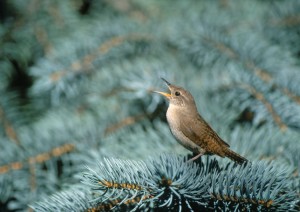You Don’t Need an App for That
Predict the Weather With Clues From Nature
Story and photos by Lisa Densmore

In April, the itch to get outdoors needs a good scratch, yet spring notoriously brings some of the most extreme weather in Vermont. It might be sunny and 70 degrees when you head out on that long-anticipated first bike ride of the year, only to find yourself in a deluge at mile 15, with 15 miles to go. And with a strong La Nina this year, the rain might very well turn to snow.
Weather seems more erratic than a decade ago when it was simply getting warmer. Blame it on climate change. Blame it on The Weather Channel. Blame it on sun spots. Regardless of the cause, the weather has certainly gotten weirder lately, but you can predict it with a fair degree of accuracy, at least for the next 24 to 48 hours, if you are observant. Mother Nature provides many clues to the weather.
Weather is the state of the atmosphere at a given moment. You don’t need radar, satellites, or computer-generated models to read the sky. Your naked eye works just fine. Simply look up. The type and elevation of the clouds above you are a result of the current weather pattern and tell you what’s coming.
Anyone who has spent time outdoors probably knows the difference between a cumulus cloud and a stratus cloud. Likewise, they know low, dark clouds mean precipitation is coming soon, if it isn’t already falling. Cumulus clouds that build to an anvil shape warn of an impending thunderstorm. High wispy stratus clouds are harbingers of bad weather, but not for 12 to 24 hours. And when the wind whips up, a front is approaching, which also means something wet or frozen is going to fall from the sky.
In addition to reading the sky, you can also observe animal behavior and watch plants and other aspects of nature for clues to incoming weather. Some old wives tales are surprisingly accurate. Others get lucky now and again:
Judge the distance of an approaching thunderstorm by counting the time between the thunder clap and the lightning flash. Count slowly, “One one-thousand, two one-thousand, three one-thousand … ” so that each one-thousand equals approximately one second, then divide by five. In other words, for every five seconds, the storm is one mile away.
Red sky at night, sailors delight. Red sky in the morning, sailors take warning. The redness of the sky is caused by the sun’s rays reflecting off dust particles when there’s little or no cloud cover. As our weather typically comes from the west, a red sky as the sun sets in the west means a high-pressure system (good weather) is coming. A red sky as the sun rises in the east means the high-pressure system has passed to the east. A storm system may be approaching, especially if the sky is deep, fiery red, a sign that it contains a lot of water vapor. However, if the air is polluted, all bets are off. Air pollution can cause red skies both morning and evening regardless of the weather pattern.
Geese won’t fly before a storm. Some people believe that geese, which are large, heavy birds, have a harder time taking off when air pressure is low because the air is slightly thinner. More likely, they simply sense the impending storm and stay put. Other waterfowl do the same, as do seagulls, which cluster on sheltered beaches.
If the bubbles in your coffee gather in the center of your cup, the day will be fair. Java forecasting relies on the way air pressure affects the surface tension of coffee in a mug. It must be strong, brewed coffee to have enough oil in it to work, and the mug must have straight up-and-down sides. Stir your coffee, creating bubbles. If the bubbles amass in the middle, you’re in a high-pressure system that is making the surface of your coffee slightly convex. (Bubbles are mostly air so they migrate to the highest point.) It’s going to be a beautiful day. If the bubbles form a ring around the sides of the mug, you’re in a low-pressure system, making the surface of your coffee slightly concave (lower in the middle). Rain is likely.
Bugs disappear an hour before a storm. Mosquitoes and black flies are thickest from about 12 hours to one hour before a storm hits, then they take cover. If the bugs stop biting, put on your raingear. Bees stay close to the hive, too, when the weather is going to get worse.
Springs flow faster when a storm approaches. Low barometric pressure associated with an approaching storm can cause a natural spring to flow out of the ground faster.
Ponds appear muddier when a storm approaches. Low-pressure can cause ponds to look cloudier because muck from the bottom rises toward the surface due to a higher volume of marsh gases.
Caves give off cold air when a storm approaches. If you stand in front of a cave when a low-pressure system approaches, you feel cold air rush out. However, this is not the only time a cave “breathes out.” If the temperature outside the cave is warmer than the temperature inside the cave, the cold air will rush out as it naturally attempts to equalize with the warm air.
Hair gets curlier as humidity rises. Hair can get wavier or curlier as humidity rises because hair tends to contract (curl) when it’s wet, and relax (straighten) when it’s dry. Canvas, hemp and other natural fibers do as well. However, wood does the opposite, expanding when wet and contracting when dry. If your axe has a wooden handle, the handle feels looser in fair weather and tighter if rain is coming. The higher humidity preceding the storm swells the wood.
 Songbirds sing louder just before a storm. Maybe. Some people believe in the opposite theory, that songbirds become quiet just before a storm. It depends on the species. Unless you really know your birds, this is an unreliable method of weather forecasting.
Songbirds sing louder just before a storm. Maybe. Some people believe in the opposite theory, that songbirds become quiet just before a storm. It depends on the species. Unless you really know your birds, this is an unreliable method of weather forecasting.
Sound travels farther when a storm approaches. High humidity and increased wind from the approaching low-pressure system both help carry sound waves farther.
If the wind dies suddenly, it’s about to pour. Often called the calm before the storm, if the wind has blown steadily for the last few hours and clouds are developing, then suddenly it all stops, take cover. You’ve got only moments before it pours.
If smoke rises in a straight column from your evening campfire, expect a fair day tomorrow. On a calm night, smoke rising vertically means a high-pressure system is upon you. On the other hand, if campfire smoke stays low to the ground, then disperses, a low-pressure system has arrived, and you could get wet.
Count cricket chirps to tell the temperature. If you count the chirps of a cricket for 14 seconds, then add 40, you can figure out the air temperature in Fahrenheit. For example, if you hear 20 chirps, it’s 60 degrees outside. Crickets are correct within a degree or two more than 75 percent of the time. Close enough.
Deer migrate to a lower elevation when the weather is about to worsen. All hoofed animals, such as deer, sheep, cows, and moose, head for sheltered valleys when a storm approaches. If you notice ungulates in the lowlands, hopefully you are already wearing your raincoat. The storm is virtually upon you.
If you see a circle around the moon, it will rain or snow soon. A halo around the moon, which is caused by cirrostratus clouds, means a warm front approaches. Expect precipitation, but it might take two to three days to arrive.
What about rainbows? We usually associate rainbows with clearing weather, but that’s not always true. If a rainbow appears on a cloudy day and does not form a smooth curve, blustery weather approaches. If you see a double or triple rainbow, lucky you! The weather is going to be gorgeous, at least for now, though rain is on its way. Perhaps that has nothing to do with the rainbow. It’s just the normal spring weather in Vermont.



